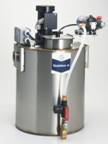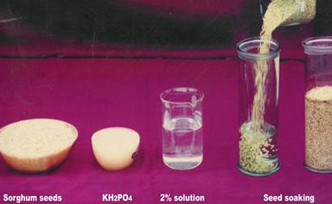SEED TREATMENT
Seed treatment refers to the application of fungicide, insecticide, or a combination of both, to seeds so as to disinfect and disinfect them from seed-borne or soil-borne pathogenic organisms and storage insects. It also refers to the subjecting of seeds to solar energy exposure, immersion in conditioned water, etc. The seed treatment is done to achieve the following benefits.
Benefits of Seed Treatment:
1) Prevents spread of plant diseases
2) Protects seed from seed rot and seedling blights
3) Improves germination
4) Provides protection from storage insects
5) Controls soil insects.
Types of Seed Treatment:
1) Seed disinfection: Seed disinfection refers to the eradication of fungal spores that have become established within the seed coat, or i more deep-seated tissues. For effective control, the fungicidal treatment must actually penetrate the seed in order to kill the fungus that is present.
2) Seed disinfestation: Seed disinfestation refers to the destruction of surface-borne organisms that have contaminated the seed surface but not infected the seed surface. Chemical dips, soaks, fungicides applied as dust, slurry or liquid have been found successful.
3) Seed Protection: The purpose of seed protection is to protect the seed and young seedling from organisms in the soil which might otherwise cause decay of the seed before germination.
Conditions under which seed must be treated
1) Injured Seeds: Any break in the seed coat of a seed affords an excellent opportunity for fungi to enter the seed and either kill it, or awaken the seedling that will be produced from it. Seeds suffer mechanical injury during combining and threshing operations, or from being dropped from excessive heights. They may also be injured by weather or improper storage.
2) Diseased seed: Seed may be infected by disease organisms even at the time of harvest, or may become infected during processing, if processed on contaminated machinery or if stored in contaminated containers or warehouses.
3) Undesirable soil conditions: Seeds are sometimes planted under unfavourable soil conditions such as cold and damp soils, or extremely dry soils. Such unfavourable soil conditions may be favourable to the growth and development of certain fungi spores enabling them to attack and damage the seeds.
4) Disease-free seed: Seeds are invariably infected, by disease organisms ranging from no economic consequence to severe economic consequences. Seed treatment provides a good insurance against diseases, soil-borne organisms and thus affords protection to weak seeds enabling them to germinate and produce seedlings.
Equipments used for Seed Treatment:
 |
 |
 |
 |
| Slurry Treaters |
Direct Treaters |
Home-made drum mixer |
Shovel |
Precautions in Seed Treatment:
Most products used in the treatment of seeds are harmful to humans, but they can also be harmful to seeds. Extreme care is required to ensure that treated seed is never used as human or animal food. To minimise this possibility, treated seed should be clearly labelled as being dangerous, if consumed. The temptation to use unsold treated seed for human or animal feed can be avoided if care is taken to treat only the quantity for which sales are assured.
Care must also be taken to treat seed at the correct dosage rate; applying too much or too little material can be as damaging as never treating at all. Seed with a very high moisture content is very susceptible to injury when treated with some of the concentrated liquid products.
If the seeds are to be treated with bacterial cultures also, the order in which seed treatments should be done shall be as follows
i) Chemical treatments
ii) Insecticide and fungicide treatments
iii) Special treatments
Chemical treatments to improve germination and vigour potential
Soaking / treating the seeds with nutrients, vitamins and micronutrients etc.,
Examples
Paddy
Seeds can be soaked in 1% KCL solution for 12 hours to improve the germination and vigour potential

Sorghum
Seeds could be soaked in NaCl2 (1%) or KH2PO4 (1%) for 12 hours for improving the germination and vigour potential.

Pulses
Seeds can be soaked in ZnSO4, MgSO4 and MnSO4 100ppm solution for 4 hours to improve the germination and vigour potential.
|